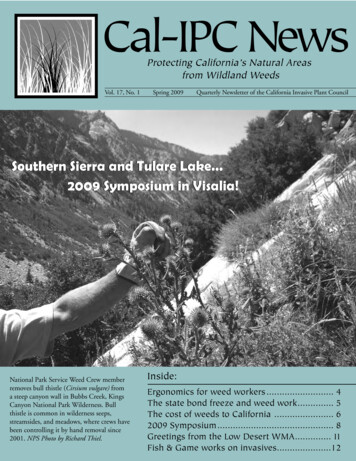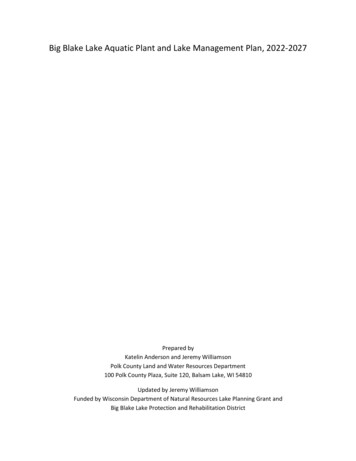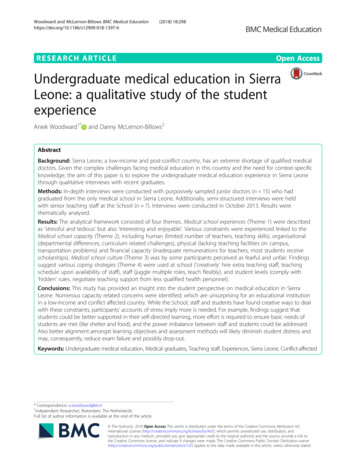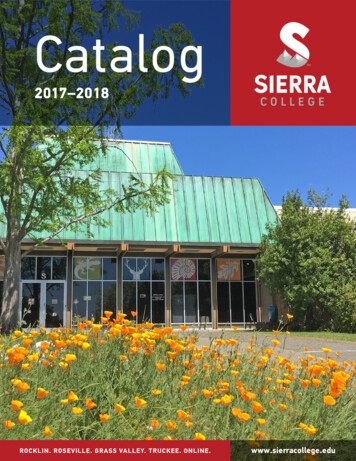
Transcription
Cal-IPC NewsProtecting California’s Natural Areasfrom Wildland WeedsVol. 17, No. 1Spring 2009Quarterly Newsletter of the California Invasive Plant CouncilSouthern Sierra and Tulare Lake.2009 Symposium in Visalia!National Park Service Weed Crew memberremoves bull thistle (Cirsium vulgare) froma steep canyon wall in Bubbs Creek, KingsCanyon National Park Wilderness. Bullthistle is common in wilderness seeps,streamsides, and meadows, where crews havebeen controlling it by hand removal since2001. NPS Photo by Richard Thiel.Inside:Ergonomics for weed workers. 4The state bond freeze and weed work. 5The cost of weeds to California . . 62009 Symposium. 8Greetings from the Low Desert WMA. 11Fish & Game works on invasives.12
CaliforniaInvasive PlantCouncil1442-A Walnut Street, #462Berkeley, CA 94709(510) 843-3902fax (510) 217-3500www.cal-ipc.orginfo@cal-ipc.orgA California 501(c)3 nonprofit organizationProtecting California’s natural areasfrom wildland weeds throughresearch, restoration, and education.STAFFDoug Johnson, Executive Directordwjohnson@cal-ipc.orgElizabeth Brusati, Program Manageredbrusati@cal-ipc.orgHeather Brady, Project Coordinatorhjbrady@cal-ipc.orgBertha McKinley, Program Assistantbmckinley@cal-ipc.orgDIRECTORSJason Giessow, President (2009)Santa Margarita/San Luis Rey Weed Management AreaWendy West, Vice President (2009)U.C. Cooperative ExtensionCarolyn Cromer, Treasurer (2009)The Land Trust of Napa CountyJohn Knapp, Secretary (2009)Native Range, Inc.Dan Gluesenkamp, Past President (2009)Audubon Canyon RanchEdith Allen (2010)University of California-RiversideJason Casanova (2010)Los Angeles/San Gabriel Rivers Watershed CouncilDoug Gibson (2010)San Elijo Lagoon ConservancyHenry Gonzales (2010)Ventura County Department of AgricultureJulie Horenstein (2010)California Department of Fish & GameBeth Keer (2009)East Bay Regional Parks Botanic GardenMarc Lea (2010)San Luis Obispo County Department of AgricultureCheryl McCormick (2010)Santa Lucia ConservancyTanya Meyer (2009)Yolo County Resource Conservation DistrictFrom the Director’s DeskBig strides—forward and backOn February 9, California took a big step forward in invasive species coordination byformally creating an interagency Invasive Species Council. Creating the council hasbeen a goal of Cal-IPC’s for several years. I count this as a significant accomplishment forour organization and I am excited about the opportunities it presents.The new council was announced at the World Ag Expo by Secretary of Food & Agriculture A.G. Kawamura and Secretary of Natural Resources Mike Chrisman. They willlead the council, which also includes Cal EPA, Caltrans, Dept. of Health Services, and CalEmergency Services. Federal agencies, tribal and local governments, universities and privatestakeholder groups will serve on an advisory council.In forming such a council, California follows other states including Oregon, Washington, Hawaii, Idaho and Arizona. Though we will not have the benefit of a 5 millionbudget like the New York council, we will be able to build on the experience of other states.Cal-IPC’s advocacy goals include both “strategy and structure”. Our risk mapping aimsto provide baseline data for designing sound statewide strategy. The new council offers astructure for implementing such broad strategy. Now our job is to help the council be aseffective as possible.At the same time as the state recognizes the importance of invasive species in creatingthis council, organizations working on the issue are being damaged by the economic crisis.In a move that puts the situation in stark relief, The Nature Conservancy disbanded theirhighly regarded Global Invasive Species Team as part of organization-wide layoffs. JohnRandall, director of the team, was last year’s recipient of Cal-IPC’s Jake Sigg Award for Vision and Dedicated Service. Cal-IPC has written to TNC to urge that they maintain focuson invasive species as a core part of their mission.Many Cal-IPC members, including several on our board of directors, have lost employment recently. Though the promise of federal stimulus dollars may help replace lost statefunding in the short term, the long term situation remains troubling. We will continueto work in coalition with othersseeking solutions to the state bondfreeze’s impact on restoration projects. We will also continue working to educate public and privatefunders about the importance ofcontrolling invasive weeds. Hopefully we will look back on thistime as a shake-up that resulted inincreased, not decreased, capacity toprotect California’s wildlands frominvasive plants.Mark Newhouser (2009)Sonoma Ecology CenterAffiliations for identification purposes only.Last year of term noted.Cal-IPC NewsSpring 2009 - Volume 17, Number 1Editors: Elizabeth Brusati, Doug Johnson, Heather BradyCal-IPC News is published quarterly by the California InvasivePlant Council. Articles may be reprinted with permission fromthe editor. Submissions are welcome. Mention of commercialproducts does not imply endoresement by Cal-IPC. We reservethe right to edit all work. Cal-IPC News Spring 2009Heading to the Capitol, Cal-IPC’sDoug Johnson and Ingrid Hogle ofthe Invasive Spartina Project get setfor legislative visits during the 2009Invasive Weeds Awareness Day atthe Capitol, March 11.
Wildland Weed NewsNewsNewsNewsNewsCal-IPC UpdatesWe’re on Facebook!We’ve joined the social networkinguniverse with a new Cal-IPC Facebookgroup. Join and keep up on Cal-IPCannouncements between newsletterissues. And don’t forget that the CalIPC Student Chapter has their ownFacebook group to help students shareideas.New Reduced Book PricesThanks to a reduction in the publisher’sprice, we are able to reduce our pricesIt is with great regret that we announcethat The Nature Conservancy has cutits Global Invasive Species Team and theaccompanying website tncinvasives.ucdavis.edu (formerly tncweeds.ucdavis.edu). Manyof its resources, including the photo gallery,Weed Control Handbook, and ElementStewardship Abstracts, will be moved toother servers such as the University ofGeorgia’s Center for Invasive Species andEcosystem Health (a.k.a the Bugwoodnetwork, www.bugwood.org). One of thecasualties is their new Invasipedia. We hopeto have more information on where theseresources find a home in the next issue.The fires that burned in Southern Californialast fall wiped out native vegetation insome areas, leaving wildlife with no placeto go and opening up places for weeds toinvade. At Chino Hills State Park, nativeshrubs and trees died in the fire and blackmustard, milk thistle, and wild radish havemoved in. Many California gnatcatchers, afederally-listed threatened bird, died in thefire and the endangered least Bell’s vireo willfind damaged nesting habitat when theyreturn this spring. Riverside Press-Enterprise,3/23/2009.Princeton Researchers studying five invasivespecies in the western U.S. suggest thatwhile climate change will allow somespecies to expand their ranges, othersmay retreat, creating opportunities forrestoration. They studied temperature,rainfall, and other factors where cheatgrass,for Weeds ofCalifornia andOther WesternStates to 80(was 103)and the set ofBroadleaf andGrass WeedsCD-ROMs to 50(was 58). Tax and shippingare additional. Take advantage of thisStimulus Package Special! Go to www.cal-ipc.org/shop or call (510) 843-3902.spotted knapweed, yellow starthistle,tamarisk, and leafy spurge now grow andcompared them to changes predictedin the next 100 years. Yellow starthistleis likely to spread in California whiletamarisk will remain approximately thesame. This study is published in GlobalChange Biology. .htmScientists in Hawai’i have a new tool toremove invasive algae that is choking reefs inthe islands. The Super Sucker is a modifiedgold dredger that runs on biodiesel and canremove up to 800 lbs of algae per hour.Alien algae are a serious threat to Hawaii’scoral reefs because they fill in crevicesand flatten the complex reef topography.Smaller, more portable, versions of theSucker are also being tested. Unfortunately,due to budget cuts, the State of Hawai’ihas not delivered the promised fundingneeded to expand the program. The NatureConservancy, Hawai’i, www.nature.orgOregon nurseries can no longer propagateor sell named cultivars of butterfly bush(Buddleia davidii) due to its invasivenessin the Northwest. In 2004, the OregonDepartment of Agriculture banned thesale of the species but excluded all namedornamental cultivars. However, laterresearch showed that all cultivars contributeto butterfly bush’s spread. Nurseries haveuntil the end of 2009 to sell existing stock.(Cal-IPC considered butterfly bush for ourInventory but did not add it because mostof California would not be suitable habitat.)The Oregonian,11/17/2008.A new study may help guide effortsto intercept invasive species carriedintentionally or accidentally by airlinepassengers. Researchers at the Universityof Florida examined travel patterns andweather to predict when invasive species aremost likely to be transported and surviveon airlines, comparing when conditionsat origination and destination sites aremost similar. June 2010 emerged as oneupcoming period with heightened potentialfor transport of invasives. University ofFlorida, news.ufl.edu/2009/02/25/travel-bugs.continued page 152009 Field Course season beginsOur Wildland Weed Field Courseskicked off the 2009 season on April1 and 2 at San Diego’s SycamoreCanyon/Goodan Ranch OpenSpace. This year’s schedule offerscourses on control techniques,biology/identification, revegatation,mapping, and new advanced courseson mechanical control and chemicalcontrol techniques. Courses areheld around the state, and we offera significant registration discount tovolunteer stewards. Get full detailsonline at www.cal-ipc.org.Cal-IPC News Spring 2009
Tools and TechniquesThinking less to do more:Ergonomics make weed work more effectiveBy Ken Moore, Wildlands Restoration TeamSince 1990, Ken Moore has directed the Wildlands Restoration Team, a volunteer programdedicated to protecting and restoring biologicaldiversity on state parklands in the Santa Cruzmountains. They have pioneered non-herbicidal control methods for many invasive plants.Ken is a frequent instructor at Cal-IPC fieldcourses and is well-known for designing andfacbricating new tools to make weed workmore effective. In this essay, he urges weedworkers to consider how ergonomics can makea difference in their work.We are an interesting species, to say theleast. We are increasingly absorbedwith using our amazing brain to come upwith ways to avoid doing anything evenhinting at serious work with our bodies. Iwon’t speculate on where this may lead us,but it has already resulted in our being dramatically less physically capable than othermammals even half our size.While some things can be accomplishedquite well by pushing buttons, I doubt thatcontrolling wildland weeds on the groundis likely to be one of them anytime soon.Herbicides, biocontrol, fire, heavy equipment, flaming: all are valuable componentsof controlling weeds on a landscape scale.But human-powered control methods willalways be necessary. Indeed, most of myfield hours are still spent in this way, despitemy insatiable fascination with trying everynew mechanical contrivance and method Ican come up with!Of course, if we can use that powerhousebrain of ours to keep from doing physicalwork, we can also use it to devise ways touse our bodies more efficiently. The basicprinciple here is to understand and utilizewhat our bodies have become best suitedfor: repetitive small motions rather thansheer strength. To travel long distances, welearned early on that we could get much Cal-IPC News Spring 2009further by takingmany small stepsrather than bigimpressive looking leaps.When I wasstill a youngster, Ireceived a lessonthat I know nowto be a universaltruth. As I arrived at my veryfirst day on aconstruction job,an old timer sawmy awkwardness,and walked over.“Do you knowhow to build ahouse, son?” heasked. “I have no Ken frilling a tree. Hand tools accomplish tasks taking a series of smallidea,” I blurted.bites—we can significantly increase our overall effectiveness by optimiz“One nail at aing the ergonomics of each small bite.time” was hisreply.complish large tasks, we must maximize ourLook at any hand-held tool, think oflimited strength and energy by increasinghow it works, and you will realize that it—just a little—the work we get done withdoes so by doing just a little bit at a time.each small motion.A good tool simply does just a little bitThe tools we use in weed control (inmore with each movement. And that’s thedeed, all tools) operate on this same princisecret—a little bit more. That’s why theple: they are designed to maximize the effectdesign of the tool, coupled with its correctof small repeated movements to accomplishuse, is so critical to success. In order to aca task, rather than fast or strenuous exertion.A hand saw, for instance, works by removingWant to learn more about mechanicalminute particles of wood with each stroke.methods for controlling invasiveAnd a very good one used properly will doplants? Come to our Advancedso with nearly no effort. Sure, we can use aMechanical Methods Control Coursechainsaw to supply more power and get thein the Santa Cruz Mountains on Julyjob done faster, but the principle is still the21. Ken Moore will be one of thesame. It still makes sawdust—just more ofinstructors. For more informationit, and quicker!about the course, visit www.cal-ipc.I became intrigued with how muchorg or contact Project Coordinatordifferenceefficient design can make inHeather Brady at hjbrady@cal-ipc.repetitivesmallmovements many years agoorg or (510) 843-3902.continued on page 14
FundingState bond freeze slows weed workWe don’t need to tell anyone readingthis that the freeze on state bondfunding has caused severe impacts to naturalresources projects in California. The LosAngeles Times (Jan. 21) estimated the bondfreeze has affected 1,100 restoration andconservation organizations. The SierraNevada Alliance surveyed 68 organizationsin the Sierra Nevada in January and foundthat ten had laid off staff, 26 had laid offcontractors, and two had closed completely.Most of those organizations’ projects relatedto restoration and water quality. Cal-IPCitself has two projects stopped.To make matters worse, state support isoften used as required matching funds forother grants, and the loss of state supportwill cost organizations other funding as well.Due to the seasonality of most restoration work, a short time without fundingcan translate into a full year lost. The YoloCounty Resource Conservation District losta year’s worth of saltcedar removal on CacheCreek without its grant from the WildlifeConservation Board. The Sierra NevadaAlliance reported that five organizations areunable to host AmeriCorps crews withoutstate funds, losing the work those volunteerswere going to accomplish this summer.The California Council of Land Trusts(CCLT) has been pressing the Dept. of Fi-nance and the legislature to develop creativesolutions to get the money flowing again.Some agencies are willing to issue a “guarantee of payment” to their grantees, statingthat if grantees are able to continue workthrough other funes, the agency will payfor that work as soon as funds are available.However, no date has been set for whensuch payment might occur. CCLT says theydo not expect most bond-funded restorationprojects to be restarted in 2009.One positive note in all of this is thestate’s action to open up sales of “privateplacement bonds” to individual investors inthe “Buy California Bonds” campaign. Andin the first bond sale, the State Treasurer’soffice sold 6.5 billion in infrastructurebonds in two days, far exceeding the 4 billion in three days they had expected.However, we do not know when projectswill be allowed to move forward, or wheninvoices for last fall’s work will be paid. TheCalifornia Prompt Payment Act requiresthe state to pay invoices within 45 days ofreceipt or pay a penalty, but the act exemptsnonprofits from receiving these penalties.This means that once bond funding canbe distributed again, nonprofits such asCal-IPC are likely to be at the end of theline as the state pays private companies andother vendors first to avoid penalties. StateSenator PatriciaWiggins hasintroduced SB553 to close thisloophole.We hopethat by the timeyou receive thisnewsletter, someof these optionshave met withsuccess and thefuture of bondfunded projectslooks more optimistic.Stopped in their tracks. A crew from Clean Lakes, Inc., cleaning aMarshMog amphibious vehicle after treating hybrid Spartina in SanFrancisco Bay. Coastal Conservancy funding for the Invasive SpartinaProject has been halted. Photo by Drew Kerr, Invasive Spartina ProjectSome projects on hold:Cal-IPC - Two projects halted, one formapping arundo from the Mexican borderto Monterey County and estimating its economic impacts, the other for workshops oninvasive species management in the Delta.Los Angeles and San Gabriel RiversWatershed Council - 2 million in workand four jobs lost. Halted projects assistedcities, predominantly low-income minoritycommunities, on restoring and revitalizingparks and streams.Mission Resource Conservation District(San Diego Co.) - 700,000 of completedwork is unpaid, and 3.5M is frozen forarundo removal projects addressing floodand fire risk and restoring habitat.Santa Ynez River Tamarisk and ArundoProject (Santa Barbara Co.) - Delay on thisproject to eradicate tamarisk and arundo onthe 90-mile river risks a significant increasein cost due to an increase in the amount ofplants to control.Invasive Spartina Project (S.F. Bay) - Thislarge eradication project to reverse damageto bayshore habitats and flood channels isnearing completion after five years of work,but skipping control efforts for one seasonwill set the project back several years. Tenjobs are on hold.Sonoma Ecology Center - The staff of 20 at the SEC conducts restoration work innorthern California watersheds. The organization has laid off several employees, andhas cut hours for most staff.Tahoe Resource Conservation DistrictThe RCD is unable to staff educationalwork on terrestrial invasive weeds. Tahoerelies heavily on educated community volunteers to assist with early detection.More information:ReSeed California - updates and adiscussion board on efforts to renewfunding. http://stopworkimpact.ning.comCalifornia Bondswww.buycaliforniabonds.comCal-IPC News Spring 2009
ImpactsThe cost of weeds to CaliforniaBy Elizabeth Brusati, Cal-IPC Program ManagerAt least 82 million per year. That isCal-IPC’s conservative estimate of annual expenditures on invasive plant control,monitoring, mapping, and outreach effortsin California based on a survey of organizations that work on invasive plants.The impacts of invasive plants includedisplacement of native plantsand the wildlife that dependson them, increased wildfires,infrastructure damage, reducedrecreational opportunities andreduced agricultural or ranching yields. Invasive species arefrequently cited as the second-most damaging factor forendangered species after urbandevelopment (Wilcove et al.2000). Many of the impactsof invasive species do not lendthemselves to easy economicvaluation. After all, how muchis an endangered plant worth?Calculations on the cost ofinvasive plants sometimes usesubstitutes such as the damage caused by floods on a riverinfested with giant reed or thereduced agricultural yield in apasture covered by leafy spurge.outreach to determine what is spent annually on invasive plants in California asan indirect way of measuring economicimpacts. We focused on invasive plants inwildlands, areas outside of human habitation or cultivation, rather than agriculturalweeds. Some of the programs we surveyedHowever, it is no simpletask to compile impacts for anentire state or to separate outdamage that can be attributedto invasive plants. Determining the economic impacts ofinvasive plants is hindered bythree factors: lack of data on the Full-color factsheet. Download at www.cal-ipc.org.plants; lack of a framework forvaluing non-market impacts (i.e. “ecosystem also fund research into control methods butfunction”) and considering uncertainty; and we did not focus on research as a category.lack of case studies that apply economicBecause there are hundreds of organizationsanalysis to invasive plants. In Cal-IPC’sacross the state working on invasive plants,recent Research Needs Assessment (Robison our results rely on some extrapolation (dis2009, see article in Winter 2009 issue ofcussed later). Our estimate is conservativeCal-IPC News), many participants pointedfor several reasons. First, it was impossibleout the need for better information on theto cover all of the hundreds of organizationseconomic impacts of wildland weeds.across the state working on invasive plants,from federal agencies to local “Friends of theWe surveyed expenditures on invasiveCreek” groups, and our extrapol. Second,plant control, monitoring, mapping, and Cal-IPC News Spring 2009we did not include the many individualprivate landowners removing invasive species (though some of the grant programs wesurveyed do distribute money to landowners). Finally, because we are surveyingexpenditures as a proxy for impact, the factthat most programs are underfunded tendsto make our estimate low.How data was gatheredWe surveyed state andfederal agencies, county agricultural departments, land trustsand conservancies, resourceconservation districts (RCDs),utility companies, and nonprofit organizations. SustainableConservation (facilitator of theCalifornia Horticultural Invasives Prevention partnership)conducted an initial survey in2007 and Cal-IPC followedup with a more extensivesurvey in 2008. We asked eachorganization to estimate howmuch they spend annually onwork related to invasive plants.To avoid double-counting,we asked them not to includefunds received from state orfederal grants in the totals theyreported. We interviewed stateand federal agencies directly toask how much money they distribute to weed work throughtheir programs.For several types of organization (e.g. RCDs), we extrapolated from a set of respondeesto estimate expenditures from the wholecategory of organization. For RCDs andcounty agriculture departments, we extrapolated based on the number of organizationsin that category in California. For landtrusts, we extrapolated based on the numberof trusts and conservancies (CaliforniaCouncil of Land Trusts 2008). We did nothave a way to extrapolate for parks and openspace districts or utilities, so we only usedfigures from survey respondees.
ResultsOur results show that state agencies spendthe most on invasive plants, at least 25million per year. This does not include allbond-funded projects as we were unable toobtain comprehensive information on bondfunded projects. We had limited surveyresults from parks and open space districts,so the estimate for that category is probably low given the many local and regionaldistricts scattered across California.Our estimate would be much higher ifagencies and other organizations receivedthe level of funding they believe necessaryto make their programs fully effective. TheCalifornia Noxious and Invasive Weed Action Plan (CDFA 2005) compiled figureson existing and needed budgets for invasiveplant control by state and federal agencies(before the current round of budget cuts).For example, the Dept. of Boating andWaterways the 7 million per year spentto control Brazilian elodea (Egeria densa)and water hyacinth (Eichhornia crassipes) inthe Sacramento-San Joaquin Delta represents only 58% of what they need in orderto reach their state-mandated goals. TheDept. of Parks and Recreation receives only12-15% of the necessary funding to combatweeds on its lands.Long-term, the cost of removing plantsincreases when programs that are notadequately funded are forced to choosebetween species or sites, allowing someinfestations to become larger and moreexpensive problems. If plants grow back dueto lack of funds for monitoring or follow-uptreatments, money is wasted.Other estimatesA number of authors have tried to put a dollar value on the damage caused by invasivespecies. One of the most widely-cited figuresis the estimate by David Pimentel and colleagues at Cornell University that invasivespecies cause 120 billion in damage inthe United States per year (Pimentel et al.2005). They also found that 42% of specieson the federal threatened or endangeredspecies lists are there primarily because ofinvasive species.One detailed analysis on the cost-benefitratio of eradicating a particular invasiveplant shows how the values add up on alarge scale. Erica Zavaleta of UC Santa Cruzquantified the impact of saltcedar (Tamarix ramosissima) by calculating the costs toLocal/Regional NonprofitsParksUtilitiesCountyAg. Depts.State agenciesType of OrganizationAnnual WeedExpendituresState agencies 26 MFederal agencies 21 MLand trusts andconservancies 10 MResource ConservationDistricts 10 MRCDsCounty agriculturedepartments 6 MLand trustsRegional Parks and OpenSpace 4 MNonprofit organizations 3 MUtilities 2 MTotal 82MFederal agenciesWhat’s spent on wildland weeds. Expenditures on weed projects in California by type oforganization. This serves as a conservative baseline estimate of statewide impacts.water supply, flood control, and wildlife.She compared the cost of a program foreradicating saltcedar in the western UnitedStates to the benefits that would be gained,and found a net total benefit of between 3.8 billion and 11.2 billion over 55 years(Zavaleta 2000).Even the Marines have to contend withinvasive species. Camp Pendleton spent 200,000 in emergency funds in 2005 toremove arundo debris that had washeddownstream onto a beach during winterfloods. The base also spent 1.2 million overfive years to remove arundo and tamariskfrom training areas. Meanwhile, at FortHunter Liggett the Army has a program toremove yellow starthistle because it tears upparachutes that cost 4000 apiece to replace(Westbrook et al. 2005).One weed with some estimates of itscost in California is yellow starthistle, whichinfests 14.3 million acres in the state, anincrease of 80% just since 1985 (Pitcairnet al. 2006). Gerlach (2004) compared thewater used by yellow starthistle to otherspecies and estimated that the value of waterlost ranges from 16-75 million/year inthe Sacramento River watershed alone. Onrangeland, yellow starthistle can reduce thecapacity of pastures by 50% and cause theoverall value of the forage to drop 6-7% peryear (DiTomaso et al. 2006). In California,yellow starthistle is managed on 500,000acres at a cost of 25/acre, for a total directcontrol cost of 12.5 million (DiTomasoet al. 2006). If the weed is not managed,control costs increase as it spreads ontoneighboring properties.Recreation is another area where invasiveplants cause economic impacts. In Nevada,one study estimated that invasive plantscause between 6 million and 12 millionper year in reduction of wildlife-related recreation (Eiswerth et al. 2005). This includedimpacts on swimming, boating, fishing,hunting, and wildlife viewing. The authorscalculated their estimate based on the totalrevenue from recreation in Nevada, the levelof weed infestation in parts of Nevada, andthe subsequent reduction in recreation. InCalifornia, expenditures on wildlife-relatedrecreation in 2006 were estimated at 8billion compared to 917 million in Nevada(US Dept. of Interior and US Dept. ofCommerce 2006). A reduction similar inpercentage to that in Nevada yields a lossof 52 million to 104 million a year inwildlife recreation caused by invasive plantsin California.We hope that these survey results willconvey the impact of invasive plants topolicymakers and members of the public.Attendees at Invasive Weeds Awareness Dayat the Capitol in March made sure everystate legislator’s office received a copy of thefactsheet. Cal-IPC will continue to collectdata to improve these estimates, and workwith researchers to develop robust studies ofactual impacts.continued page 13Cal-IPC News Spring 2009
2009 Cal-IPC SymposiumThe Leading Edge. this year’s Symposium brings you theme sessions on halting the leading edge ofspreading weed populations, leading edge tools and techniques, and leading edge research on climatechange and longterm ecological processes. Join 300 other weed workers in Visalia for the 18th annual CalIPC Symposium!Invited and Contributed Paper SessionsPoster and Exhibitor SessionReception & Awards BanquetField Trips and Field CourseDiscussion GroupsRaffle & AuctionCome share the latest in wildland weed biology and management!"Wildland Weed ManagementOctober 8-10, 2009Field Course: Advanced Herbicide Control Methods.October 7, Kaweah Oaks Preserve, VisaliaWant to learn more about how to effectively and appropriately use herbicides to controlweeds? This course is designed to provide more detailed information about chemicalcontrol than is provided in our basic Control Methods Field Course. Topics will includemodes of action, selectivity, application methods, calibration for proper application rate,personal and environmental safety, and specific treatment strategies for different types ofweeds. particular methods used for more. Instructors include Dr. Joe DiTomaso of UCDavis and others with extensive experience controlling wildland weeds with herbicides.DPR Continuing Education units will be available (specific hours will be listed on ourwebsite this summer). Register with the Symposium and receive a discount. Cal-IPC fieldcourses provide attendees with reference information, lunch, and a great opportunity tonetwork with instru
remove invasive algae that is choking reefs in the islands. The Super Sucker is a modified gold dredger that runs on biodiesel and can remove up to 800 lbs of algae per hour. Alien algae are a serious threat to Hawaii's coral reefs because they fill in crevices and flatten the complex reef topography. Smaller, more portable, versions of the










